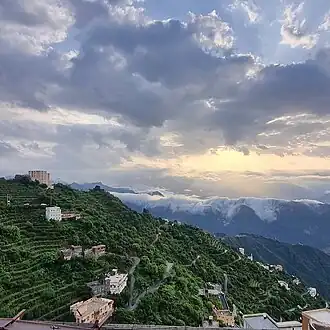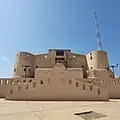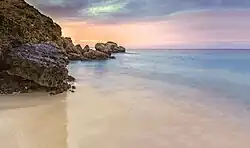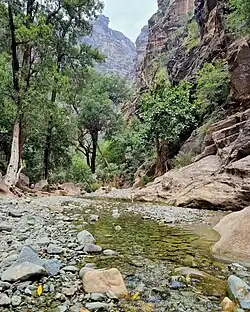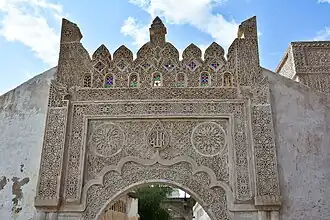Jazan Province
Jazan
جازان (Arabic) | |
|---|---|
Al-Dosariyah Castle Beach in Farasan Islands Wadi Lajab Al-Rifai House, Farasan | |
 Seal | |
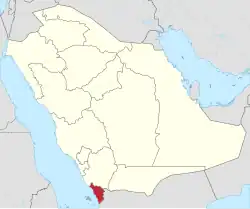 Map of Saudi Arabia with Jazan highlighted | |
| Country | |
| Region | South Arabia |
| Capital | Jizan |
| Governorates | 17 |
| Government | |
| • Body | Municipality of Jazan |
| • Governor | Mohammed bin Abdulaziz |
| • Deputy Governor | Nasser bin Mohammed.[1] |
| Area | |
• Total | 13,457 km2 (5,196 sq mi) |
| Population (2022 Census) | |
• Total | 1,404,997 |
| • Density | 100/km2 (270/sq mi) |
| Demonym(s) | Jazani (Male) Jazania (Female) |
| Time zone | UTC+03:00 (SAST) |
| ISO 3166-2 | SA–09 |
| Area code | 09 |
| Website | www |
Jazan Province, also known as Jazan Region (Arabic: منطقة جازان Minṭaqat Jāzān) is the second smallest of the provinces of Saudi Arabia, after Al-Bahah. It stretches approximately 300 km (190 mi) along the southern coast of the Red Sea, just north of the border with Yemen. Covering an area of 13,457 km2, it had a population of 1,404,997 according to the 2022 census.[2] The Province has the highest population density in the Kingdom.
The province includes over 200 islands in the Red Sea.[3] One of the major developments in the province is the Jazan City for Primary and Downstream Industries, a large-scale project intended to contribute to the province’s economic development.[4] The Farasan Islands, Saudi Arabia's first conservation protected area, are home to migratory birds from Europe during the winter.
History
Ancient times
Jazan (Jizan) dates back to the Stone Age, as confirmed by archaeological studies and research carried out in the region, which showed that the first human settlement was during the Lower Paleolithic. Tools belonging to the age of the Acheulean civilization have been found, and surveys have shown that the Red Sea coast region is one of the best sources of information on the Acheulean stage. Due to the proliferation of hunting tools found by excavations, researchers inferred that the inhabitants of the Acheulean settlements relied for their survival on seafood, such as fish and shellfish, given their availability and nutritional value.[5]
In light of its important strategic position situated on ancient trade routes between Yemen and Hejaz, on the one hand, and between the Levant and beyond, on the other, Jazan Province maintained cultural links with the ancient kingdoms that thrived in that period in the south of the Arabian Peninsula. Human settlement in Jazan was contemporaneous with those kingdoms, such as the Minaean Kingdom, Kingdom of Sheba, Kingdom of Qataban, Kingdom of Hadhramaut, and the Himyar Kingdom. However, Jazan was not politically subordinate to any of them; in fact, archaeological evidence suggests that the inhabitants of the region were not in agreement with those neighboring kingdoms and governed according to their own interests.
Islamic age
Jazan Province has been an Islamic Arab territory since the early Islamic age. A delegation from the region journeyed to Muhammad in Medina in the tenth year of his migration, headed by the chieftain of al-Hakam tribe, Abduljad Bin Rabia al-Hakami, and declared their embrace Islam. After the spread of Islam in the south of the Arabian Peninsula, Mohammed appointed provincial governors in these multiple territories, including the province of Tihamah, with which Jazan was affiliated.[6]
Saudi era
After the founding King Abdulaziz reclaimed the rule of Riyadh and established the Kingdom, the King led unification campaigns throughout the Arabian Peninsula. At the time, the region of Jazan and Tihamat-Aseer southwest of the Arabian Peninsula was subject to a local chiefdom ruled by one of its dynasties, the Idrisids in the Emirate of Asir. The Treaty of Makkah (1926) was concluded between the founding king and the region’s ruler, al-Hassan al-Idrisi, on October 21, 1926. Under the treaty, the territory came under the mandate of King Abdulaziz and was so for four years, until the treaty was annulled by the Idrisid rulers. Consequently, the founding King sent his troops to recapture the territory, and al-Hassan al-Idrisi ceded his rule in 1930; thus, Jazan was the last region of the Arabian Peninsula to join Saudi rule.[7]
Geography
The province divides into three parts.
- The Sarawat Mountains inland, which rise to about 3,000 metres.
- The Al-hazoun forest district consists of forest broken by some areas of rich pasture.
- The plains are noted for the production of coffee beans, cereal grain crops (barley, millet and wheat) and fruit (apples, bananas, grapes, mangoes, papayas, plums and citrus varieties).
Though the climate on the highlands is similar to the relatively wetter climate of Asir, the coastal regions of Jazan province are part of Tihamah, probably the hottest place in the country, with mean maximum temperatures ranging from 40 °C (104 °F) in July to 31 °C (88 °F) in January. High humidity from coastal lagoons makes the climate even less bearable than it would be otherwise. Rainfall is extremely low at less than 75 millimetres (3 inches) per year. Sabya is located in the center between the mountain and the beach.
Population
| Year | Pop. | ±% p.a. |
|---|---|---|
| 1992 | 865,961 | — |
| 2004 | 1,157,587 | +2.45% |
| 2010 | 1,264,845 | +1.49% |
| 2018 | 1,373,659 | +1.04% |
| 2022 | 1,404,997 | +0.57% |
| sources:[8][9] | ||
Governorates
The province is divided into 17 governorates, classified into categories A and B based on the availability of services.[10][11]
| Governorate | Category | Population (2004 census) | Population (2010 census) | Population (2022 census) |
|---|---|---|---|---|
| Abu Arish | A | 123,943 | 196,462 | 187,060 |
| Al Dayer | B | 49,239 | 58,325 | 47,424 |
| Al Darb | B | 52,062 | 70,740 | 68,965 |
| Ahad al Masarihah | B | 70,038 | 109,866 | 130,545 |
| Al Aridhah | 62,841 | 76,033 | 79,730 | |
| Al Aydabi | B | 52,515 | 61,043 | 32,940 |
| Al-Harth | B | 47,073 | 23,496 | 11,561 |
| Ar Rayth | B | 13,406 | 19,022 | 16,877 |
| Bish | B | 58,269 | 77,406 | 86,996 |
| Damad | B | 62,366 | 71,256 | 64,136 |
| Farasan | B | 13,962 | 18,015 | 13,529 |
| Fayfa | B | – | – | 19,346 |
| Jizan | 255,340 | 163,703 | 200,911 | |
| Sabya | A | 198,086 | 227,519 | 223,083 |
| Samtah | A | 128,447 | 201,959 | 154,925 |
| Harub | – | – | 30,709 | |
| At Tuwal | B | – | – | 36,259 |
| Total Province | 1,187,587 | 1,374,845 | 1,436,706 |
Ethnography
The Arabic language is spoken by over 90% of the inhabitants. Parts of Jazan was claimed to be part of a "Greater Yemen" by many Yemenis despite never being ruled from Yemen since the fall of the Himyar Kingdom at 525 CE. Since that period, the areas of Jazan province has been mostly independent and it has also been part of the First Saudi state during the 18th century. Jazan has been annexed by Saudi Arabia in 1932 and was defended from a Yemeni invasion that lead to the Saudi–Yemeni war in 1934 and Imam Yahya suspended Yemen's claim to the province in the treaty of Taif. Though many Yemeni nationalists continued to claim jazan until the issue was settled formally and finally in the Saudi-Yemeni border agreement of 2000.[12]
Climate
Jazan Province's climate is impacted by tropical winds, and the weather is generally very hot in summer and mild in winter, except for the mountain highlands, where temperatures are moderate and there is rainfall throughout the year.
Humidity
The humidity level is 50% in the area west of the Jazan Valley Dam and decreases as we head east.
Precipitation
The precipitation occurs during the late summer and early fall months and is characterized by irregular patterns. In some years, there are heavy rainfall events that support agricultural activities, and the dam captures a significant portion of these precipitation levels. Conversely, in other years, there are minimal rainfall events that are insufficient for agricultural production.[13]
Economy
Jazan’s attractiveness for business investment is helped by its location on the Red Sea close to the Horn of Africa and the Yemeni border, which generates various export and commerce opportunities for all industrial, agricultural, and fish producers in the region.[14]
In April 2023, Crown Prince Mohammed bin Salman announced the establishment of 4 new special economic zone (SEZ), one of which is located in Jazan. It covers a total are of 24.6 sqkm and aims to open up opportunities for international investors.[15] The SEZ aims to attract $2.93 billion in foreign investments by 2040.[16]
Fishing
The coastline of Jazan is approximately 330km long. Jazan yields 6,394 tons of fish and shellfish each year. According to a report issued by the Jazan Chamber of Commerce, the annual yield includes 1,753 tons of narrow-barred Spanish mackerel, 1,261 tons of Lethrinidae, 87 tons of shellfish, 794 tons of bagrus, 740 tons of barracudas, 444 tons of sharks and rays, 469 tons of groupers, 442 tons of mixed fish, and 428 tons of tuna.[17] This amounts for more than 20% of Saudi Arabia's fish production.[18]
Agriculture
Jazan is considered one of the most important and fertile agricultural regions of Saudi Arabia. The region produces more than 30 types of fruits, including mangoes, guavas, papayas, and more. Other agricultural varieties include coffee and wheat.
In May 2022, the Saudi Public Investment Fund (PIF) launched the Saudi Coffee Company, which aims to make Saudi coffee a global product. The PIF is expected to invest more than $319 million over the next 10 years in the national coffee industry, to help boost annual production from 300 tons to 2,500 tons.[19]
According to the Ministry of Environment, Water, and Agriculture, Jazan’s livestock population exceeds 3.977 million, including more than 1.72 million sheep, 2.1 million goats, about 95,400 cattle and 57,400 camels.[20]
Metal Conversion Industries
The geographical location of the Jazan region is pivotal to the development of mining-related manufacturing industries. The Arabian-Nubian Shield and its proximity to the mineral-rich African continent constitute a competitive advantage and an important source of raw materials.[21]
Monuments and tourist attractions
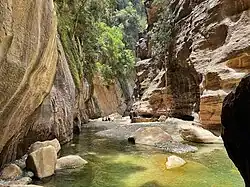
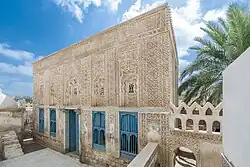
- Al Dosariyah Castle
- Al Rifai House, Farasan Islands
- Wadi Lajab
- Wednesday Market (Souq al-Samil)
- Al-Asha roundabout
- Al-Zahir
- Al-Khazan Alshamly.
- Dar al-Nasr Castle.[22]
- Al Qubbab Mosque, Abu Arish
Local market
The Abu Arish popular market is a significant commercial hub within the city. It is also known as the Robua Market and the Samil Market. It is a traditional market that has been in operation for an extended period, attracting a considerable number of individuals from various villages within the Abu Arish Governorate on a weekly basis to engage in commercial activities. The market displays a variety of traditional household items, including crockery, tools crafted from palm fronds, textiles utilized for clothing, agricultural implements, and animals. The market, which still exists today every Wednesday, is an ancient gathering place for the people of Abu Arish and its surroundings.[23]
Infrastructure
Education
The city of Abu Arish has been known for study circles since old times, as circles were held in the city's mosques to teach the Qur'an and Hadith. From its notable scholars include Abdullah ibn Ali al-Amoudi and his son, Saleh ibn Abdullah al-Amoudi, as well as Abdullah Adam, Muhammad Zakri, and Musa al-Manqari. Subsequently, Abdullah Al-Qaraawi's educational institutions were established, and over time, conventional schools proliferated, reaching a total of 65 schools for girls and approximately 66 schools for boys.[24]
Faculties and institutes
Source:[25]
- The College of Shari'ah and Law is affiliated with Jazan University.
- The College of Arts and Humanities is affiliated with Jazan University.
- Community College for Girls is affiliated with Jazan University.
- Technical College for Girls in Jazan.
- Manahil Knowledge Institute for Women's Education and Training.
- Maharat Institute - Jazan Contractors Alliance for Training and Employment.
Healthcare
Abu Arish City is home to a 150-bed public hospital that offers a range of medical specialties, in addition to two primary care centers. Among the most prominent hospitals located within the city:[26]
- Abu Arish General Hospital.
- Chest Diseases Hospital.
- Jarash Medical Hospital.
- Safwa Dental Clinic.
- Al-Salama dispensary.
- Almariya Medical Center.
- Al-Hakami Medical Complex.
- Dr. Daifallah Daqdaki Center.
- Al-Hayat Specialty Center.
- Al-Hayat Medical Center.
Transportation
Air
Jazan Province is currently served by King Abdullah bin Abdulaziz International Airport. A new airport, the New King Abdullah International Airport, is under development and will replace the existing facility upon completion.
Roads
Sports
Jazan is home to 7 professional sports clubs:[27]
- Al-Tuhami Club based in Jizan. The club was founded in 1948.
- Al-Yarmouk Club based in Abu Arish. The club was founded in 1970.
- Al-Amjad Club based in Sabya. The club was founded in 1974.
- Hatten Club based in Samtah. The club was founded in 1976.
- Al-Sawari Club based in Farasan Islands. The club was founded in 1978.
- Al-Watan Club based in Damad. The club was founded in 1980.
- Fayfa Club based in Fayfa. The club was founded in 2015.
List of governors
| Name | Term of Office | Monarch(s) |
|---|---|---|
| Turki bin Ahmed al-Sudairi | 1952 – 1977 | Abdulaziz, Saud, Faisal, Khalid |
| Mohammed bin Turki al-Sudairi | 1977 – 2 April 2001 | Khalid, Fahd |
| Mohammed bin Nasser | 2 April 2001 – 8 May 2025 | Fahd, Abdullah, Salman |
| Mohammed bin Abdulaziz | 8 May 2025 – present | Salman |
See also
- Provinces of Saudi Arabia
- List of governorates of Saudi Arabia
- List of cities and towns in Saudi Arabia
References
- ^ "King Salman issues 14 royal decrees including new regional governors and senior officials". Saudigazette. 8 May 2025. Retrieved 8 May 2025.
- ^ "Population Characteristics Surveys" (PDF). General Authority for Statistics. 2017.
- ^ "أرخبيل سعودي من 264 جزيرة.. آثار ولؤلؤ وشواطئ ساحرة" [A Saudi Archipelago Consisting of 264 Island: Artifacts, Pearls, and Fascinating Beaches]. alarabiya.net (in Arabic). Alarabiya. 23 January 2019. Retrieved 31 March 2025.
- ^ "Jazan Economic City Quarter Report" (PDF). Rcjy.gov.sa. 2017. Archived from the original (PDF) on 15 December 2018. Retrieved 13 December 2018.
- ^ Inglis, Robyn; Alsharekh, Abdullah; Sinclair, Anthony; Shuttleworth, Andrew (15 January 2014). "Investigating the Palaeolithic Landscapes and Archaeology of the Jizan and Asir Regions, Southwestern Saudi Arabia". Retrieved 8 March 2024.
- ^ "Jazan City". saudipedia.com. Saudipedia. 29 May 2024. Retrieved 8 March 2025.
- ^ "Jazan City". saudipedia.com. Saudipedia. 29 May 2024. Retrieved 8 March 2025.
- ^ "Saudi Arabia: Regions & Major Cities - Population Statistics, Maps, Charts, Weather and Web Information". www.citypopulation.de.
- ^ "Age structure". stats.gov.sa. General Authority for Statistics. Retrieved 8 March 2025.
- ^ "Detailed results of JIZAN (general population and housing census 2010-2010)" (PDF). General Authority for Statistics. 23 February 2016.
- ^ "Population Characteristics surveys 2017" (PDF). General Authority of Statistics.
- ^ Schmitz, Charles; Burrowes, Robert D. (25 October 2017). Historical Dictionary of Yemen. Rowman & Littlefield. p. 269. ISBN 9781538102336.
- ^ Jazanvoice- Abu Arish Land of the Domes History of the Kings of Arabia 1.
- ^ Al-Thaqafi, Tareq (17 March 2021). "Geostrategic location of Saudi Arabia's Jazan province makes it ideal for investment: business leader". arabnews.com. Arab News. Retrieved 5 March 2025.
- ^ "Four new special economic zones to be established in Saudi Arabia". arabnews.com. Arab News. 13 April 2023. Retrieved 8 March 2025.
- ^ "Jazan's economic zone to attract $2.93bn in foreign investments by 2040". arabnews.com. Arab News. 11 June 2023. Retrieved 8 March 2025.
- ^ "Jazan Yields over 6,300 Tons of Fish, Shellfish Annually". spa.gpv.sa. Saudi Press Agency. 6 May 2024. Retrieved 8 March 2025.
- ^ "Jazan provides Kingdom with 20% of its fish production". saudigazette.com.sa. Saudi Gazette. 9 May 2020. Retrieved 8 March 2025.
- ^ "Saudi sovereign fund PIF launches coffee company". reuters.com. Reuters. 15 May 2022. Retrieved 8 March 2025.
- ^ "Jazan's fertility, livestock nourish Saudi Arabia's future". arabnews.com. Arab News. 24 September 2024. Retrieved 8 March 2025.
- ^ "Metals Conversion industries".
- ^ The most important tourist attractions of Abu Arish Governorate in Saudi Arabia.
- ^ "The activity of popular markets in Jazan | Jazan Today" (Bar-SA). Archived from the original on 2019-04-18. Retrieved 2019-04-18.
- ^ Jazan School Guide.
- ^ Jazan Universities.
- ^ 10 hospitals in Jazan among the top ten in patient satisfaction in the Kingdom.
- ^ "قائمة الأندية الرياضية في منطقة جازان" [List of Sports Clubs in Jazan Region]. Saudipedia (in Arabic). Retrieved 8 March 2025.
Further reading
- S.I. Bruk, Narody Peredney Azii (1960).
- S.I. Bruk, and V. S. Apenchenko, Atlas Narodov Mira (Moscow: Academy of Science, 1964).
- A. Gabriel, Religionsgeographie von Persien (Vienna, 1971).
External links
- Official website
- A travel through the province of Jizan, Splendid Arabia: A travel site with photos and routes
